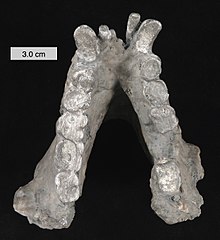Gigantopithecus
| Gigantopithecus | |||
| Koenigswald, 1935[1] | |||
| Okres istnienia: 1–0,3 mln lat temu | |||
 Żuchwa gigantopiteka | |||
 Rekonstrukcja gigantopiteka | |||
| Systematyka | |||
| Domena | |||
|---|---|---|---|
| Królestwo | |||
| Typ | |||
| Podtyp | |||
| Gromada | |||
| Infragromada | |||
| Rząd | |||
| Podrząd | |||
| Nadrodzina | |||
| Rodzina | |||
| Podrodzina | |||
| Rodzaj | gigantopitek | ||
| Typ nomenklatoryczny | |||
Gigantopithecus blacki Koenigswald, 1935 | |||
| Synonimy | |||
| |||
| Gatunki | |||
| |||
Gigantopitek (Gigantopithecus) – wymarły rodzaj ssaka naczelnego z rodziny człowiekowatych (Hominidae), który żył milion do trzystu tysięcy lat temu[4], na obszarze dzisiejszych Chin, Indii i Wietnamu obok innych gatunków hominidów[5]. Zachowane skamieniałości sugerują, że Gigantopithecus blacki był największą małpą człekokształtną, jaka kiedykolwiek żyła, osiągającą do 3 m wysokości i 540 kg wagi[4][6][7].
Etymologia
- Gigantopithecus: gr. γιγας gigas, γιγαντος gigantos „ogromny, olbrzymi”[8]; πιθηκος pithēkos „małpa”[9].
- Gigantanthropus (Giganthropus): gr. γιγας gigas, γιγαντος gigantos „ogromny, olbrzymi”[8]; ανθρωπος anthrōpos „człowiek”[10]. Nowa nazwa dla Gigantopithecus Koenigswald, 1935.
Gatunki
- Gigantopithecus blacki Koenigswald, 1935
Kryptozoologia
Niektórzy kryptozoolodzy uważają, że gigantopitekami są takie istoty jak Yeti, Wielka Stopa, Yowie, Yeren i Skunk ape[11][12].
Uwagi
- ↑ Niepoprawna późniejsza pisownia Gigantanthropus Weidenreich, 1946.
Przypisy
- ↑ G.H.R. von Koenigswald. Eine fossile Säugetierfauna mit Simia aus Südchina. „Proceedings of the Koninklijke Nederlandse Akademie van Wetenschappen”. 38 (8), s. 874, 1935. (niem.).
- ↑ F. Weidenreich: Apes, Giants and Man. Chicago; London: University of Chicago Press; Cambridge University Press, 1946, s. 59. (ang.).
- ↑ H. Weinert. Über die neuen Vor- und Frühmenschenfunde aus Afrika, Java, China und Frankreich. „Zeitschrift für Morphologie und Anthropologie”. 42 (1), s. 124, 1950. DOI: 10.2307//25753107. (niem.).
- ↑ a b Jane Christmas: Giant Ape lived alongside humans. McMaster University, 2005-11-07. [dostęp 2007-12-06]. [zarchiwizowane z tego adresu (2012-02-06)].
- ↑ R. Ciochon i inni, Dated Co-Occurrence of Homo erectus and Gigantopithecus from Tham Khuyen Cave, Vietnam, „Proceedings of the National Academy of Sciences of the United States of America”, 93 (7), 1996, s. 3016–3020, DOI: 10.1073/pnas.93.7.3016, PMID: 8610161, PMCID: PMC39753 [dostęp 2007-12-06] [zarchiwizowane z adresu 2009-03-07].
- ↑ Russell L Ciochon: The Ape that Was – Asian fossils reveal humanity's giant cousin. University of Iowa. [dostęp 2007-12-06]. [zarchiwizowane z tego adresu (2015-05-25)].
- ↑ Eric Pettifor: Selected Readings in Physical Anthropology. Kendall/Hunt Publishing Company, 2000, s. 143-149. ISBN 0-7872-7155-1. Rok pierwszego wydania: 1995 [dostęp 2008-01-30]
- ↑ a b Jaeger 1944 ↓, s. 96.
- ↑ Jaeger 1944 ↓, s. 176.
- ↑ Jaeger 1944 ↓, s. 18.
- ↑ Bjorn Carey: Gigantic Apes Coexisted with Early Humans, Study Finds. LiveScience, 7 listopada 2007. [dostęp 2007-12-06].
- ↑ The Bigfoot-Giganto Theory. Bigfoot Field Researchers Organization. [dostęp 2007-12-06].
Bibliografia
- E.C. Jaeger: Source-book of biological names and terms. Wyd. 1. Springfield: Charles C. Thomas, 1944, s. 1-256. (ang.).
Media użyte na tej stronie
Autor: (of code) -xfi-, Licencja: CC BY-SA 3.0
The Wikispecies logo created by Zephram Stark based on a concept design by Jeremykemp.
Autor: Wilson44691, Licencja: CC BY-SA 3.0
Lower mandible of Gigantopithecus blacki (cast). In the collections of The College of Wooster, Ohio. Cast of specimen PA83
Autor: Concavenator, Licencja: CC BY-SA 4.0
Representación ideal del Gigantopithecus blackii


